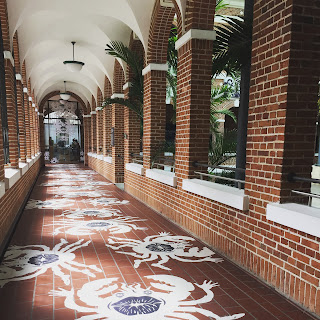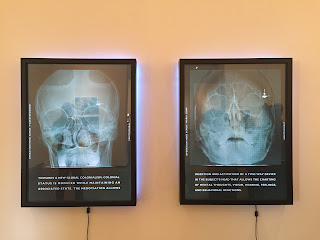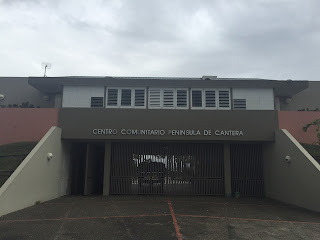Photo: CAUWW class with Dr. Palmira Rios Gonzalez
I gave this entry the headline of "the lost episodes" because there were a number of CAUWW classes that I did not properly write about while I was in Puerto Rico. In my defense, (as I mentioned previously) I was a victim of weak WiFi at the Casa Carmona - and moreover, we were learning and doing so much, in such a short period of time, I was not able to synthesize everything immediately. I digress.
First and foremost, I would like to mention Dr. Maria Elba Torres Muños, professor for the Advanced Studies of Puerto Rico and the Caribbean. She met with us on the first day of class to give us an overview of the CAUWW course, along with Dr. Marta Moreno Vega (President and Founder of CCCADI). She gave us a good foundation about the relationship between art, culture and commerce in Puerto Rico. Dr. Maria Elba would meet with us again the following week (I will write more about her second presentation, towards the end of this article).
Dr. Palmira Rios Gonzalez, a sociologist, civil rights activist, writer and teacher (who was just named Dean of the University of Puerto Rico) also met with us on our first day of class. With a most thoughtful and warm manner, Dr. Rios gave us a vast breakdown of the political and economic history of the island. This information was invaluable to our understanding and giving context to what we would encounter later on in the course.
Visual artist Antonio Carrión Torruellas gave us a wonderful class in which he began by saying, "El arte es el vehículo del espíritu" (art is the vehicle of the spirit). He showed us some of his beautiful paintings, as well as some of his silkscreen posters. (We would hear various times throughout this trip, how integral the art of silkscreen was and is in Puerto Rico.) Mr. Carrión was one of the artists involved in DIVEDCO (Division of Community Education), a social experiment run by the US Department of Education between 1949-1989, employing all forms of artwork to educate people on the island on various social and health issues. Mr. Carrión is the only surviving member of the DIVEDCO collective and he is still painting, teaching students and passing on his knowledge and spirit.
Professor Victor Ortiz, a social activist and community organizer came in and made a presentation, Working Within Community - Issues to be Considered. With a dynamic and warm energy, he explained about the importante of eco-communities, community work development, economic community development, and economic solidarity among other things. Later on in the trip we had the opportunity to visit some of the communities that he had talked about: Cooperativa Piñones se Integra (COPI) and Centro Comunitario Península de Cantera.
The same day, artist, designer ad educator María De Mater O'Neill from Rubberband PR Design Studio came in to present a workshop, Storytelling and Resilient Strategies for Creatives. This was a hands-on workshop in which she showed us how to use a Bounce & Design Toolbox that she created as a means for people to solve problems and thrive in challenging situations.
Later, we had a visit from Panama Alba who was a member of the Young Lords making a presentation, the Young Lords Party - A Political and Cultural Movement. He filled us in on the history and significance of the YLP, and recounted some of the experiences he had with them living in New York City as a young man in the 1960/70's when group was most active. His passionate first-hand accounts about the conditions under which people of color in urban areas were living under at the time was extremely poignant and relevant to so many of the issues that we are still dealing with today. His perspective on activism was inspiring as a person who participated in some very challenging feats, such as the takeover of Lincoln Hospital in the Bronx in 1970 (which resulted in lasting policy changes).
The day that we went to have class at the University of Puerto Rico in Rio Piedras, we were met first by Yolanda Arroyo Pizarro, writer, poet and cultural activist presenting on Engaging the Gender Narrative within a Traditional and Colonial Framework. She talked to us about a number of things, including the importance of self identity, culminating in her reading one of her beautiful poems to us (which made me shed a tear). Later we met with artist Pedro Lugo, who had participated in the major student strike at UPR in 2010. After his presentation, he took us for a tour of the campus to view murals made by students, some of them there since 2010 and some new. Last but not least, our CAUWW coordinator, Regina Bultron-Bengoa gave a presentation, Who's Wall is it Anyway?-Issues to Consider When Working With Public Art and Communities. Being a multi-media artist and native of Puerto Rico herself, she discussed the process in which she organized an interactive community mural project in the town of Rio Piedras for its 300-year anniversary (which we were able to go see for ourselves).
After we had had a week out on the field, Dr. Maria Elba met with us again to give us a presentation on the Hidden Art History of Puerto Rico. She explained how the traditional canon of Puerto Rican art was created in the image of its ruling countries' (first Spain then the United States) images - and she brought to light a lesser-documented "Antillean," Caribbean or Afro-Boriqua aesthetic which also exists, but under the radar in many cases. Lucky for us, Dr. Maria Elba is the foremost art historian/critic on the latter, and she has an amazing collection of visuals that she was able to share with us. Some of the artists she mentioned were: Jose Campeche, Juan DePrey, Jose Torres Martino, Carlos Raquel Rivera, Jose Maduro, Rafael Tufino and Cecelia Orta.
Later that day (after a long, hot walk through the city of Santurce) we returned to the oh-so-cold classroom (Interamerican University is serious about their air conditioning!) to meet with artist Chemi Rosado and founders of the elTaller.de organization, Felix DePortu and Javier Carrosquillo. Chemi described himself as a socially-engaged artist, showing us slides of some of his amazing work (www.chemirosado-seijo.com) and explaining the concepts behind them. His projects are fascinating in that they seem to be at the intersection of visual art, happenings, social justice, community intervention and group participation. Javier and Felix of elTaller.de (which translates into, "the workshop of...") explained to us how their organization identifies needs in various communities throughout Puerto Rico and then goes in to work with them on creating art projects, bringing in the appropriate local visual artists for the particular project.
All in all I cannot fully explain how much we learned from these presentations by people who are experts in each of their respective fields. This is obviously just a brief summary - a whole article could be written about each one of them (and probably books on some of them too).





























